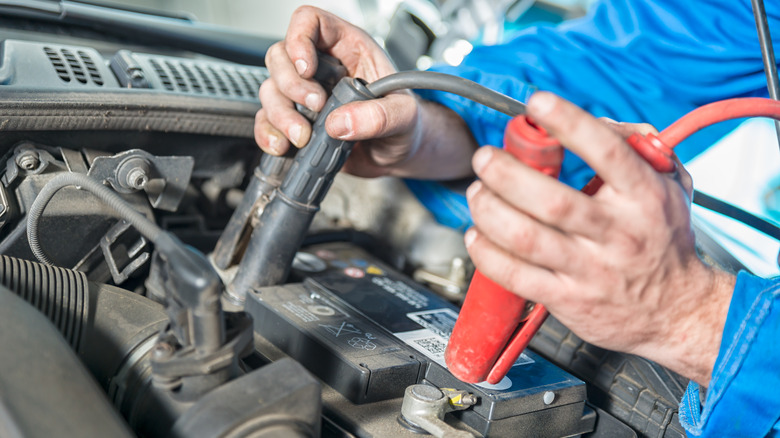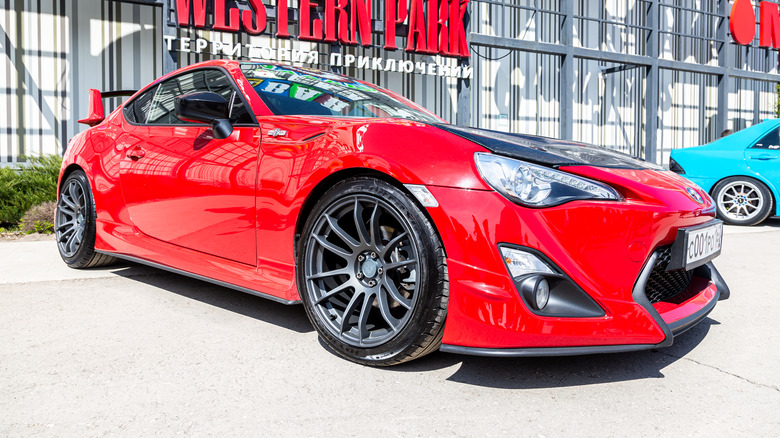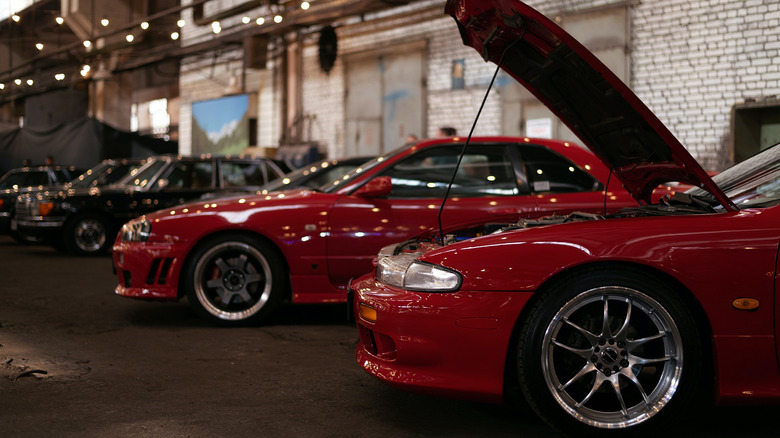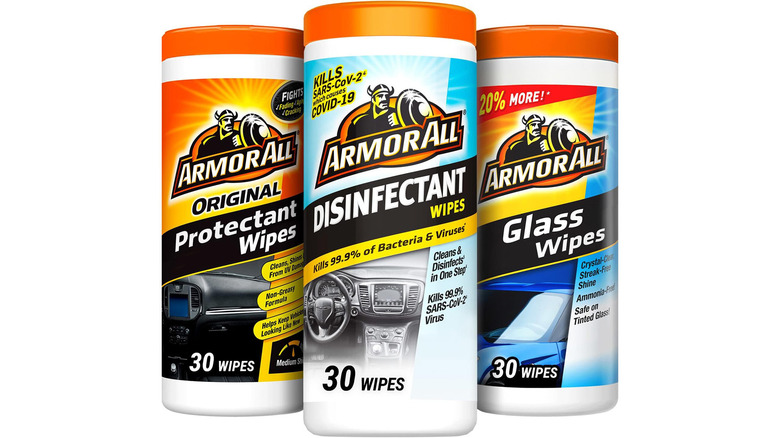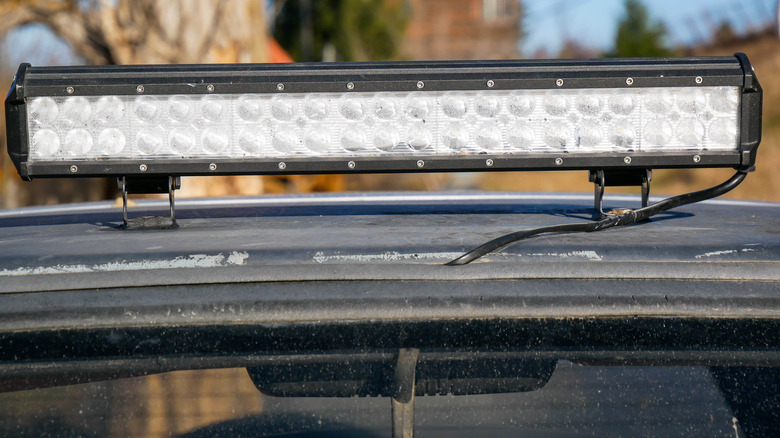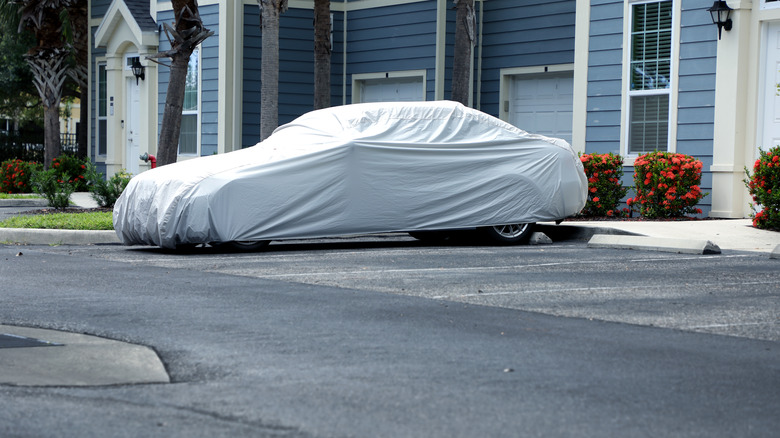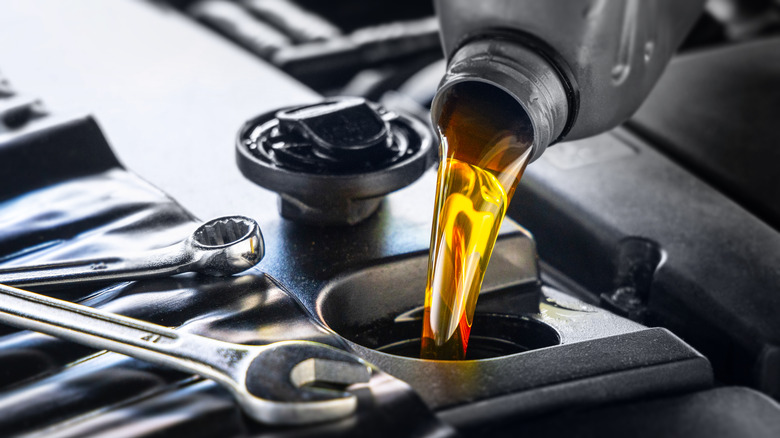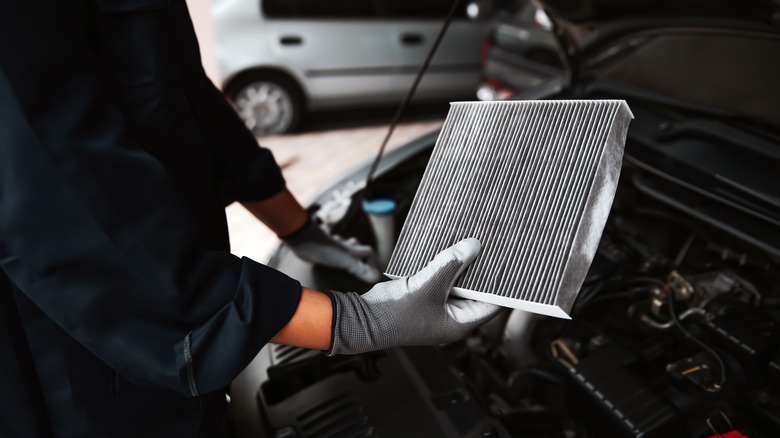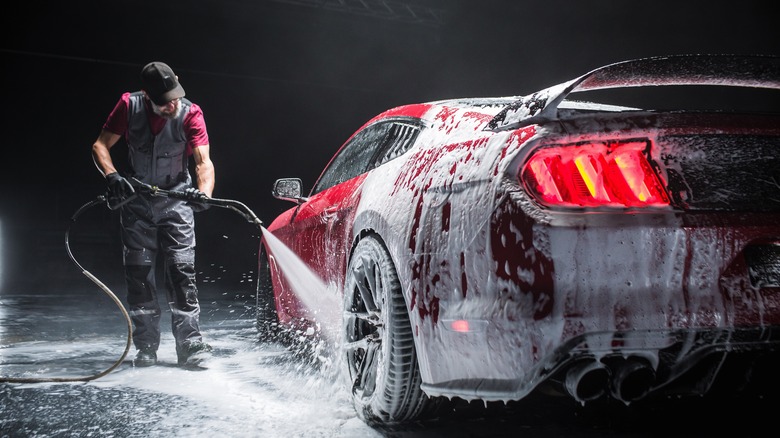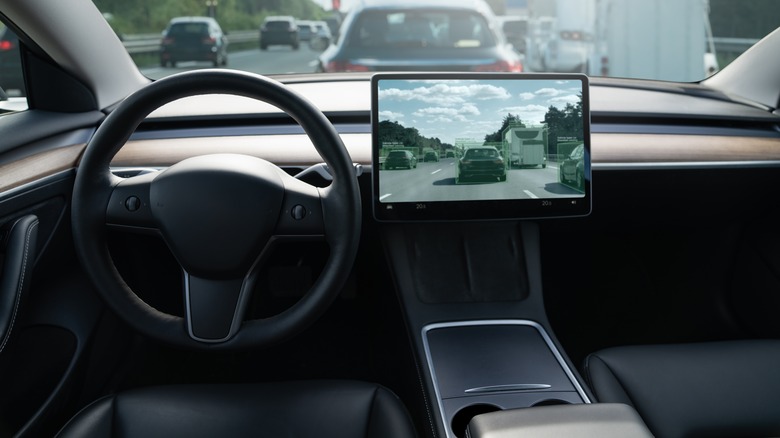10 Auto Products That Could Do Your Car More Harm Than Good
The automotive world is full of helpful tools from everyday basics like windshield wiper blades to more complex technology like rear cameras that can help you see behind your bumper when you back up. Many of these products are in your car's best interests. After all, it's a lot less likely to hit a pedestrian when you have a camera pointing right at them. Most accessories and tech on modern vehicles do quite a lot to make your drive easier, more comfortable, and safer.
However, some other products have mixed results. Typically, the intentions are good, and the product does work to some extent, but there are some underlying things that consumers either don't understand or simply don't know. In short, there are automotive products that have the potential to cause harm to the car itself. There are also products for the car that cause harm to you. One such example is the lead-acid battery that almost every car uses. It doesn't take a rocket scientist to see the potential hazard with something that uses both "lead" and "acid" in its name. Proper use of such batteries avoids any complications, but it's a good example.
Here are 10 automotive products that have the potential to cause real harm to either you, your car, or both. This isn't meant as a fear-mongering type of article, but rather a friendly PSA to remind you to make sure you're using products correctly to avoid damage to yourself and your vehicle.
Large rims
Large rims are probably the best example of a product that tons of people use that can cause a lot of damage to a car. Many modern cars even come with larger rims and low-profile tires as part of a more expensive trim package. It looks quite nice, and that's why people started doing this to begin with. Low-profile tires have been around for decades, but they really took off during the late 1990s and early 2000s rap scene.
Large rims and low-profile tires look awesome when they're done correctly, but they also come with some potential problems. For starters, tires are a part of a car's suspension system and the only part to make contact with the road. Low-profile tires look nice, but their stiffer, smaller sidewalls mean that the tires aren't absorbing as much of the road as a car with thicker, softer sidewalls. This translates to a harsher overall ride, and it also adds more work for the suspension components, which can wear them out prematurely.
In addition, cars won't take larger bumps or potholes as well as low-profile tires, which can lead to your very expensive, very large rims getting scuffed or even cracked. This actually happens a lot, and it's one of the most common causes of wheel damage on cars equipped with large rims and low-profile tires. Locales with nicer year-round weather where there is a lower chance of massive road imperfections may be able to handle a car like that, but if you live where there's snow and ice, you may want to invest in a slightly smaller rim and a thicker tire. Your passengers and suspension system will thank you.
Almost any aftermarket modification
As an extension to the above, almost any aftermarket modification can have a negative impact on your car. We have covered large rims already, but other wheel modifications like spacers, negative and positive cambers, and even suspension modifications like coilovers and lift kits can cause damage to your suspension system if installed or used incorrectly. Even with proper installation, a lowered car has a much higher chance of bottoming out and damaging the undercarriage.
It doesn't end there. Aftermarket turbo or supercharger kits and nitro tanks can cause accelerated engine wear, especially if you don't apply an engine tune after modification. Not only can modifications like that void your warranty, but they're expensive and can really mess up your car. This is especially true if modifications are done incorrectly. Good luck asking your dealership to add a positive camber to your car.
This isn't to say that modifications are harmful, or that you can't do them. It's your car, after all, and many cars run for years with modifications. However, it is a friendly reminder to take your time and do it correctly while also understanding the intrinsic dangers of messing with how your car works. Engineers have very specific specs, such as engine timings, to ensure proper operating. Messing with that can irreparably damage any car, even if it's known to hold a tune well.
Car washes
A car wash is one of those things that can cause harm to your car, but the harm isn't horrible. It's not like your engine is going to explode if you go to a car wash. Similarly, it's not going to flat strip the paint off of your car unless the paint was coming off that bad anyway. However, the one-size-fits-all nature of them along with those massive brushes can definitely scratch your paint job, especially if you use one consistently. A lot of car enthusiasts invest in at-home car wash products and tools to avoid a car wash adding subtle wear to their paint job.
The type of car wash also matters. There are touchless car washes that are far less likely to cause damage, but the touchless nature means that cars don't get as clean. For traditional car washes, the issue is the debris that gets caught in the brushes from prior vehicles. For instance, if you're ahead of a truck that looks like it just spent the last two days mudding out in the boonies, you may not want to follow that car into a car wash. Car washes do self-clean, but we'd still give it a few minutes first.
For the most part, the damage caused is very minor. Some folks may not even notice it or, if they do, they may not even know it came from a car wash. People who clean their own cars have observed this as swirl patterns from where the car was improperly scrubbed. This doesn't cause harm to the functionality, but over time, it'll definitely make your paint job look less good, which may affect resale value.
Interior cleansers
There are a surprisingly large number of cleansers for both the inside and outside of a car. Each one has its own use and using the wrong one can cause damage to your vehicle. One such example comes in the form of ammonia-based window cleaners. There are short-term issues, like inhaling fumes in an enclosed space that just aren't good for you. Ammonia also has a drying effect on certain plastics and rubbers. Since the interior of car is likely made almost entirely out of plastics and rubbers, using ammonia can cause accelerated wear and cracking. You won't notice after just one use, but over time, it'll happen.
Improper use of cleansers can damage almost any part of your interior if used incorrectly. For example, using harsh cleaners on real leather seats can dry out and damage the leather. Thus, you'll want to use a cleaner specifically for leather on your leather seats. However, don't use that same cleaner on the rest of your car because it can damage the rest of your car.
Household products are similar to this. Each product you buy has a recommended set of surfaces where it's safe to use. There's almost always a list of surfaces where it's not recommended because it can cause damage. Cleansers for cars are the same way. If used improperly or on the wrong surfaces, it'll eventually cause altering damage.
LED lights and light bars
If you've ever driven passed a truck with an LED light bar mounted on the bumper or over the roof, then you know exactly what this section is going to be about. Car lights have gotten brighter and brighter, especially over the last two decades. Most cars are equipped with LED lights and some folks who need even more will light up entire neighborhoods by adding things like LED lightbars. While these LED lights certainly help the driver see better at night, it has an adverse effect on everyone else driving on the road.
The studies are still ongoing, but preliminary results show that very bright lights have an increased chance of distracting other drivers. This shouldn't come as much of a surprise. One can achieve the same effect by flashing an LED light in their own eyes. We don't recommend trying that because it hurts, but that's more or less what happens when super-bright lights flash you in the face. Car OEMs are slowly starting to grasp this concept and are designing their headlights to shine less at oncoming drivers.
A lot of people simply want to have spotlights on the front of their cars so they can see, which is understandable. However, the other side of that debate is that such lighting blinds everybody the beam touches, which can cause traffic accidents. Fortunately, this is something that carmakers know is a problem, and it's being worked on. Until a fix comes that's a good compromise for everyone, it'll remain an ongoing issue.
Car covers
Car covers are another product that won't do much damage if used properly. They only start to get a little worrisome if you put one on and take it off of your car every single day. Car covers can be made out of a variety of materials, but it's usually some sort of weatherproof plastic. Such materials are not known for being the softest in the world, however, and over a long period of time, they can scratch and scuff your paint job.
In addition, it's not just the material that can scratch your car. You can buy softer car covers and keep your car in the garage. The secondary risk is the dirt, debris, and grit that is already on the car. You put the cover on, and it rubs that grit against your car, which can scratch the paint. Those who cover their cars outside may also get scuffs where wind causes the cover to rub up against the paint job. Much like the car washes above, you won't notice this at first, but over time, it'll start to show wear on the paint.
The best use for a car cover is for long-term storage, such as covering your sports car that you don't intend to drive in the winter. Some folks recommend even washing the cover before putting it back on a car that's been driven recently, but that's a bit much. In any case, car covers have a specific use case, and that use case isn't covering your car every day while it sits outside. If you do, the covering will eventually cause issues with your paint job.
Using the wrong oil blend or oil weight
Oil is the vehicle's lifeblood, and it's responsible for lubricating all of the internal parts that would otherwise rub against each other. As such, it's always important to identify the best motor oil brands to use and make sure your oil is clean and fresh. Always get your oil changes on time and check your oil regularly to make sure there is enough in the car. Old oil is not as effective at lubrication as newer oil, which can cause engine wear over a protracted period of time.
Perhaps more important is making sure you're using the correct oil. There are three main types of oil: conventional, synthetic blend, and full synthetic. Older vehicles used conventional oil and needed an oil change every six months or 3,000 miles, whichever came first. Newer cars use full synthetic and can go 7,500 to 10,000 miles and a year between oil changes. If you use conventional oil on a car that's supposed to get full synthetic, you'll not only have to get the oil changed more often, but you risk engine damage since conventional is a lower quality oil.
Additionally, the oil comes in different weights. When shopping for oil, you may see a range of numbers 10W-30 or 0W-20. The "W" signifies that the oil is rated for use during the winter, and the numbers show that the oil can flow properly at a range of temperatures. It's not rocket science — If your car's manual says to use 0W-20 oil, then you use 0W-20 oil. Not using the proper weight can and will take a toll on the engine.
Using improper or performance-oriented engine air filters long-term
Engine air filters are a lot like oil when it comes to things that might harm your car. If you use the correct size from a reputable automotive air filter brand, then you don't have anything to worry about. However, there are several types of engine air filters out there, and not all of them are good for all types of use. Car makers generally recommend that a driver change their engine air filter every 12,000 to 20,000 miles. Thus, it's not nearly as often as you need to change your oil, but it's still recommended maintenance to keep your car running correctly.
Not changing your cabin air filter can cause some problems. If not taken care of for long enough, you'll get engine misfires, reduced output, and eventually, engine wear. Replacing that old air filter with the improper air filter will yield almost exactly the same problems. Any gaps or poor filtration will lead to dust and debris getting into the engine, creating gunk that will prevent the engine from functioning properly.
Some folks may think about getting performance filters. For short-term, track-related use, a good performance filter is a good idea. However, performance filters are thinner and let more air through than normal engine air filters. Using one on a daily driver will also allow too much dirt and debris to pass through, which will cause the same issues as not changing your previous one at all. Plus, performance filters are often oiled and require regular maintenance that isn't worth the time or the cost.
Caustic cleaners
When it comes to cleaning the outside of your car, there are a host of dos and don'ts. There are a variety of cleaners designed specifically for cars. They work fine as long as they're used properly, but there isn't a lot of information about using them properly. Some of those cleaners can contain chemicals like naphthalene, methylene chloride, and perchloroethylene. Some, such as the Eagle One Chrome Wheel Cleaner product, contain hydrofluoric acid. These chemicals may be safe for your car, but they certainly aren't safe for you. Such cleaners should be used with appropriate PPE if you choose to use them.
Abrasive cleaners can also cause problems with your paint job. Don't use standard towels, but rather use microfiber towels instead. A non-abrasive dish soap is safe to use, but household degreasers can strip the protectant off of your paint, making it more susceptible to scratches and chipping later. As with most harmful things, you likely won't notice any problems in the short term, but these are problems that can cause long-term issues if done continually.
There are a host of other cleaning-related tips and tricks for cars to avoid damage as well. Make sure not to leave wax on too long, don't use the same cloth for every task, and don't use paper towels since they can cause abrasions as well. Of course, you can do most of those things once or twice and it won't cause any permanent damage, but again, long-term use will cause long-term damage.
Self-driving technology
Self-driving modes in cars are a relatively new thing. The car essentially drives itself, which is super helpful. For most modern vehicles, these types of features only come on the upper trims, so it's something you have to spend extra money on in order to use. While excellent as a driving assist feature, it should absolutely never be completely and totally relied upon to drive your vehicle on your behalf.
The story is almost always the same. A driver tests out this awesome new technology in a safe manner and sees that it works. They come to trust the technology and something bad happens. Usually, it's just a fender bender or something of lesser magnitude, but occasionally, the consequences can be more dire. There are several stories of Tesla's Autopilot technology malfunctioning and causing massive vehicle and personal harm to the driver. Technology may get good enough over time to prevent such issues, but it's certainly not there yet.
No car manufacturer recommends that drivers use such technology and then stop paying attention to it. Drivers are to use these features as driving assistance, not driver replacement. This is more of a personal responsibility thing than a poorly made product, but warning labels exist for a reason, and all self-driving tech has the same massive warning label attached to it.
